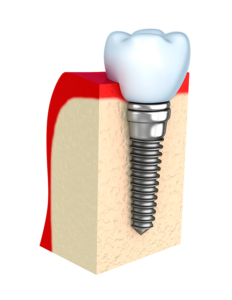Options for Bone Grafts
 Last week I talked about how we help patients who need dental implants in North York but don’t have enough bone to support the implant, and I promised to review some of the options for the different materials that we use to help grow bone. That’s what I’ll be covering in this post.
Last week I talked about how we help patients who need dental implants in North York but don’t have enough bone to support the implant, and I promised to review some of the options for the different materials that we use to help grow bone. That’s what I’ll be covering in this post.
There are basically 3 options for bone graft materials:
- Bone taken from another site in the patient’s mouth
- Bone from a human tissue bank (treated and purified human bone)
- Bone taken from an animal (usually a cow) that has been treated and purified
There are advantages and disadvantages to each of these bone sources.
Bone taken from another site in the patient’s mouth is ideally the best bone for a transplant. However, even though the patient’s own bone is the best match for the patient, and has the most growth hormones to stimulate new bone growth, it does require a second surgical site for the patient, and this can often lead to increased post-operative discomfort and healing. That is the reason why so many patients decline this option.
Bone taken from a tissue bank which has been donated, much like a kidney but far more sterile (living kidneys can’t be treated or purified), meets many of the needs to help stimulate and support bone growth without the need for a second surgical site for the patient. It is the type of bone graft most frequently chosen by patients
The final main source of bone for grafting is bovine or bone derived from cow bones. This bone also undergoes very rigorous processing to remove any contaminants or sources of infection to make it extremely safe.
Both human bone and bovine bone have their advantages and disadvantages depending on their purpose in the graft. A well trained surgeon would likely make a recommendation as to which product he would like to use and why.
So you see, there are lots of options for grafting in order to restore patients’ mouths to have the smiles and functionality of their youth (or better).
In implant dentistry, not only is a well trained surgeon a must, but the dentist who actually co-ordinates your treatment and then builds the teeth onto the implants is critical to the outcome. One of the most important choices you’ll make is to chose a dentist with the vision and skills to help their patients obtain their goals. In my office, I am fully trained to not only perform the surgery, but also to restore the implants to beautiful smiles. I am also able to offer our patients the convenience of having all their treatment in one location, which means that there are no communication breakdowns between the surgeon and the restorative dentist as can happen when treatment is provided in two different offices.
For examples of some of our patients’ outcomes, please take a minute and view some of our before and after results of patients who have had implant treatment.
Next week, I am going to focus on another aspect of my practice and that is family dentistry. Stay tuned, there is still much to learn!

